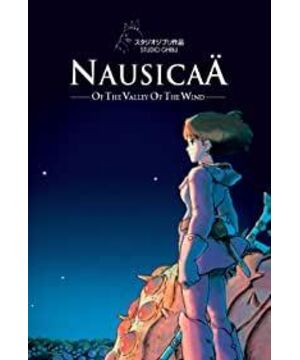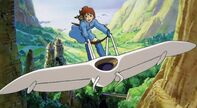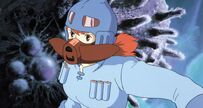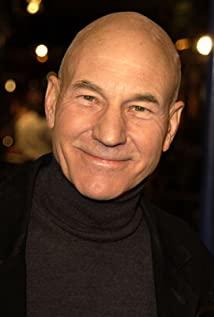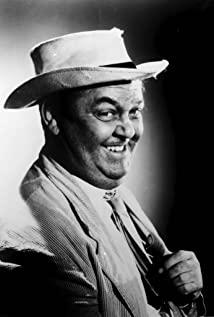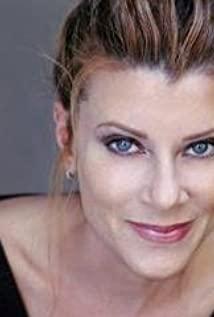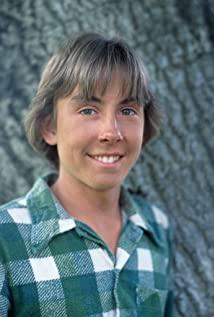Great work! 10 points!
Its core is that people and nature live in harmony, but it is even better than "Princess Mononoke"! ("Princess Mononoke" is already very good!)
======
Synopsis:
People after 1000 years do not live in heaven, but the beautiful sight is actually perilous. After the catastrophe of human self-destruction, the fungus-based Rot Sea forest exudes poisonous gas, gradually eroding human settlements, and the King Insect Group living in the Rot Sea can be destroyed in an instant. Terrorist creatures that have built new homes. The Nausicaä of the Valley of the Wind is one of the human lives in some marginal countries in the world after being destroyed by humans, and it is also a paradise. One important reason is that the valley faces the sea, and the blowing direction of the sea breeze prevents infectious spores from blowing into the valley. Another reason is that the princess of the valley Nausicaa, her wisdom and love dispelled the valley people and the king insects. Many contradictions between.
The story begins when the giant conveyor falls in the Nausicaä of the Valley of the Wind. This conveyor was originally used by Dorumekia to transport prisoners from the industrial city of "Pejit". Nausicaa rescued the girl Lasdale from the wreckage, but the girl asked Nausicaa to burn the wreckage. Although she didn't know the meaning, she agreed to make the girl feel at ease, and the girl died immediately. A huge group of beating blood vessels was found at the place of the fall the next day. That is the "Giant Soldier", the final weapon to torch the world in the "Fire of Seven Days".
After learning of the fallen Dorumekia Kingdom's Queen Kushana, she sent a large number of formations to the Valley of the Wind. Soldiers broke into the city one after another, and Nausicaa rushed to her father's room panicked by the sound of gunfire, and found that her father Kiel was exasperated. For the sake of the people in the valley, Nausicaa volunteered to be a hostage and Kushana waited for Pejit. The large conveyor boat that Nausicaa and others took, carrying other hostages and food, set off towards Pejit. On the way, he was attacked by Asberu, a young Pegit who was driving a combat boat. The ship of the invaded Domegia Kingdom fell quickly. The conveyor boat Nausicaa was riding on had already caught fire, and it was densely covered now. Nausicaa's battle boat slowly landed, and finally landed on the water surrounded by giant trees.
The water king worm informed Nausicaa that Asberu was lost in the sea of rotting, so Nausicaa bid farewell to the frightened Kushana and the old men in the city, and prepared to rescue Asberu. Asbelu, who was chased by the hordes of king insects, fell into a hollow under the giant water. When Asbelu was about to be consecrated, Nausicaa, riding on a hang glider, appeared like the wind. When Nausicaa rescued Asbelu, she accidentally fell to the ground, and the sand covered Nausicaa's body and fell into it. Finally, even the hang gliding wing was swallowed by the sand, but then there was an unexpected discovery.
After leaving the Sea of Corruption, Nausicaa learned that Pejit used a small king worm to induce a large group of king worms to the Valley of the Wind, so Nausicaa confronted the crew of the flying plane with bare hands. He pointed the gun at Nausicaa and began to attack. Nausicaa opened her arms and moved towards the moving machine. The impacted flying plane fell beside the acid lake. Nausicaa, who was thrown to the ground, endured the pain in her body and slowly approached the devastated King Insect. Then, stand up to stop the little king worm who wants to enter the acid lake. The little king worm seemed to understand Nausicaa's mind, and the little king worm's eyes turned from red to blue. And Nausicaa used her own life to stop the madly advancing crowd of king insects. After the king worm learned that Nausicaa sacrificed himself to prevent their attack, he used the golden tentacles in his mouth to heal Nausicaa's injuries and revive her again. ,
========== The
surviving people know how to enjoy life, and the dead people learn to yearn for the other side. Believe that life will change, and there will always be new possibilities in the future. So Nausicaa said: "Even a leaf, an insect, wherein the presence of our God will!"
Gentle wind ah
please ask blowing in front of our way
though white sand cover, the smoke miasma rampant
even though no grass, The only remaining homeland has also been involved in endless warfare.
But we are the twinkling lights in the darkness.
Even if the end is not far away,
we still have to sing the
last echo of
this song of evolution that has been passed down for thousands of years. The first, the first-it started in 1982, even earlier than "Kiki's Delivery Service", "My Neighbor Totoro" and "Laputa".
At that time, Hayao Miyazaki just started to serialize his full-length manga in Anime magazine: "Nausicaa of the Valley of the Wind (风の谷のナウシカ)". In this work, Hayao Miyazaki depicts an era in which civilization is over-developed, natural ecology has been exhausted, and even the space where humans live is almost completely wiped out because of fighting against each other.
In this world where the surface is like a desert, is lonely, and has an apocalyptic atmosphere, the land on which humans can survive is being swallowed bit by bit by the highly toxic forest system "Rotting Sea". The protagonist of the story, Nausicaa, is the princess of the "Nausicaa", a small country on the coast. This entire cartoon is based on Nausicaa's journey between various kingdoms, both running and wandering, and brings out the diverse dialectics of humans and nature, survival and evolution, destiny and existence, and so on. Therefore, "Nausicaa" is not only Nausicaa's personal pursuit of truth, but also the author leads the audience to find the true meaning of the "harmony" of all things on the earth.
From 1982 to 1994, "Nausicaa" was serialized intermittently for a total of twelve years. At the beginning of the serialization, in 1984, Hayao Miyazaki adapted the story of the time into an animated film version. For children of our generation, most of Miyazaki's works played a pivotal fantasy role in childhood. But my childhood favorites have always been the adventurous and exciting "Castle in the Sky" and the fascinating magical "My Neighbor Totoro". Instead, I have only fragmentary impressions of the earlier "Nausicaa".
Of course, this changed after I grew up a little bit and watched this animation again; then, two months ago, I found the full comic version of Nausicaä of the Valley of the Wind. Since then, I have a completely different understanding of this work and even the entire inner world of Hayao Miyazaki.
In the story, the Nausicaa of the Wind is protected from the miasma because of the sea breeze, and it also breeds lovely residents who are happy and live in a relatively comfortable life. But even if the end times are near, human beings with increasingly scarce resources for survival still cannot stop the war. One of the epigrams of "Nausicaa" is "The destiny of mankind is closely linked regardless of nationality. It is impossible for every community to be outside the world." Even if it is not at the core of the battle line, the wind Gu was still involved in the war between the two great empires "Dorumekia" and the "tudinous princes".
In fact, the animated version of "Nausicaa" only covers about one-third of the plot of the original. Although it is Miyazaki Hayao's work with the largest format or the most profound ambition before "Princess Mononoke", it only mentions the concepts of "respect for the will of nature" and "cherish all life", but fails to express the comics. The cruel nature of war, the arrogant face of mankind, and the destiny facing the end of the world, and even the purpose of subverting existence, described in the middle and later sections, are all a pity.
Even so, you who have watched "Nausicaa" animation will never forget: Nausicaa in blue is riding a jet glider, flying over the desert like a white kite; you must also remember: The thick and heavy king insects are covered with compound eyes, and when they are so irritated that they lose their minds, the fourteen royal blue eyes will turn bright red, and the look of the single-minded running is so desperate and sad.
Today, I actually believe that Nausicaa is the prototype of all girl characters written by Hayao Miyazaki. In his future works, you will see Nausicaa’s independence and considerateness in Gao Yue, and Xiaomei’s kindness and fearlessness towards unknown creatures in Xiaomei; and Ling Chang in Qiqi’s body. The sincere characteristics of the beloved, and the brave and agile martial arts skills in Xiao Sang's body.
Of course, perhaps, in terms of encounters, composure and understanding of life, the closest thing to Nausicaa is actually the boy character Ashidaka. But I want to leave this part to be discussed when I write "Mononoke Hime" in the future. What I want to say here is: after Hayao Miyazaki created Nausicaa, the character that best fits his image as a perfect goddess (but at the same time possessing youth and innocence), he can only use it again and again in his future works. The characteristics of Nausicaa were extracted and crystallized into different appearances.
In concept, Nausicaa cherishes all life. Even the ugly and ferocious worms, she treats them as companions or the owners of this land. In the comics, Nausicaa stretched out the hand of friendship with insect trainers (warlocks who breed insects and live with them), people who have been despised by other tribes for thousands of years and who have been shunned because of their stench. They were so grateful that they were almost horrified, and decided that Nausicaa was not a human being but a "forest of grown-up", the goddess they must worship.
Nausikala touched her cheek with the hand of the trainer and told them "Look! I am human just like you." This is the first embodiment of the concept of equality. And she further denies the value of "life that is harmful to humans is evil", based on the spore-spreading giant insects, the sea of corruption that devours the land, and even the giant soldiers in the comics and other characters with countless murders and ugly and humble hearts. All are equally tolerant.
The existence of the king insect is perhaps the most impressive setting in the animation of "Nausicaa". The image that does not rely on words and lacks physical action, but has the majesty and depth of the old man, the focus and the solemnity of acting alone. They (him?) are not only messengers of the Corrupt Sea, but also silent judges. The king insects in the animation may be a little simple, but through telepathy in the comics, there have been a lot of communication between the king insects and Nausicaa. So far, I can feel even more: in the deep blue pupils of the king insect, there is a deeper love and compassion.
Indeed, the theme of "Nausicaa" is the emergence of a "corrupt sea" on this land destroyed by mankind, an ecological system whose purpose is to purify, even if it takes thousands of years to complete its mission. Wherever the sea of rot is covered, humans cannot survive in them because of the toxic miasma. The human beings who are struggling to survive on the periphery of the Sea of Corruption will of course not know that these toxins are the karma left by the ancestors, the sins left to future generations in the era of blind faith in science and the pursuit of extreme force. The surviving people only think that the Sea of Corruption is an ecosystem that aggressively expands its territory and wants to incorporate all spaces into its territory.
So of course, humans regard the Corruption Sea as an absolute invader, and only want to burn it quickly. Therefore, in the animation, when Nausicaa found clean air at the bottom of the Corroded Sea and saw the crystals of petrified trees broken into pure white sand waterfalls, she finally understood the purpose of the Corroded Sea and the current situation. The source of seeming pessimism.
This is the touch that the daughter of the wind has finally paid for the truth. It is also Hayao Miyazaki's pessimistic expectation of this world that is gradually self-consuming and losing all respect for nature, and the glimmer of hope that still exists behind it.
Another item that is actually portrayed in more detail in the comics, but not difficult to find in the animation, is Nausicaa's natural charisma and leadership qualities. When Yuba teacher met Selmu, the only "forest man" in the comics who had the same spiritual height as Nausicaa, he remembered that "this person has the same eyes as Nausicaa." And it is this sincere, clear, determined and fearless look that makes all the characters in contact with Nausicaa in the story unable to be affected by her, and then change their original intention of acting, believe in and even willing to follow her.
In the world of Nausicaä of the Wind, despite the hardship of life and the shortage of resources, the greed for power of those in power in various countries and the continuous end of the war derived from the blood sea and family hatred have not been slowed down by the approach of the end times. In the animation, it is the zero-sum mutual annihilation between "Dorumecchia" and "Pejit", and in the comics, there are more complicated "earth ghost princes" added to it. But no matter which camp they face, Nausicaa from the Valley of the Wind is equally fraternity. Since it can't change the cruelty of the war, then try to resolve the scars of people's hearts.
For this reason, Nausicaa has infected everyone who meets her, causing them to gradually question their position, break away from the original national framework, and view the destiny of mankind from a higher level and the perspective of caring for all beings. Whether it is Kushana, the second heroine in the story, Thaluka, a monk from the land of ghosts, or the uncles of the Valley of the Wind who love and love Nausicaa and treat Nausicaa as a daughter The king insects have all become characters that revolve around Nausicaa.
And this is the charisma of the leader. When I saw him in the 20th Century Boys of Naoki Urasawa, a manga artist I admired very much, that he used the same charm to portray the leading character of the heroine Endo Shinno, I couldn’t help but think: Maybe Naoki Urasawa is Refer to Nausicaa to write this role.
But in Nausicaä of the Valley of the Wind, Miyazaki also told readers that "a perfect leader, after reaching the level of a half-human and half-god, belongs to all living beings, not a single race." So you will see Nausicaa many times and hear the call from the bottom of her heart, producing something like "The forest in the south is calling me, I must go" or "I must go to the beginning of everything to really find the answer." "Then I said that I just walked on the ground and took the white hang gliding wing, hovered in a circle to say goodbye to everyone, and then left the people who could only look at her and sigh and wander with her heart from now on. He left without returning.
And this is the loneliness of the king. Because she can't help responding to the inquiry from the bottom of her heart, and because as a messenger of harmony between human beings and nature, Nausicaa has a sense of mission for the benevolent even though she doesn't have the mind of the people. It is this self-knowledge that "it is impossible for me to do it" and "only I can benevolence the world", so that Nausicaa has the aura of a king in the later stage, and no one can stop it.
But it is also this sense of mission that makes her always non-stop and always lonely. It’s just that Nausicaa herself said: “I’m always thinking about everyone in the valley. I can feel that many people are guarding me.” Indeed, all the characters in the story are almost willing to help her afterwards. And sacrifice one's life. So she was never afraid, because such loneliness was never really lonely.
Then, before entering the next paragraph, I would like to remind my lovely readers: Next, I will inevitably mention the key plot of the comic version. Although perhaps knowing this first, it will not affect your future (if you have not seen the comic version before) the first time you will have fun, but for many readers who may be very sensitive, I still have to specify here first one time.
Compared with the animation version of Nausicaä of the Nausicaa, the most obvious difference is in "Kushana". As the prince and daughter of the Torumekia Empire, Kushana was described as the most brave, warrior, and the most beloved heir to the throne among the four heirs of King Wu.
In the animation, Kushana’s fierceness and her personality shaken by Nausicaa were only portrayed in the animation; but in the comics, Kushana was first framed by her own emperor brothers and even the king of Wu, and she was deeply saddened. Lost her beloved and proud officers. While being influenced by Nausicaa and gradually seeing the essence of the world, the idea of "revenge" that made her livelihood was wiped out the instant she witnessed the death of the emperor's brother.
So even though Kushana in the latter part of the story is fierce and unchanged, she has a more benevolent demeanor, and has shown calmness in facing death and conforming to the destiny on many occasions. But as Nausicaa said, Kushana was originally "a kind bird with a big heart and huge wings", but now it "has been hurt deeply."
Yuba teacher who was only a foil in the animation, died to protect Kushana at the end of the manga. He told her, "Your blood has been washed away by me, and it is now pure. From then on, the kingly way will be unfolded by you..." Kushana, whose hands were covered with blood, finally learned that she still has to live. Reasons to go down.
Before Yuba died, the prayer in his heart was "Gentle wind... Keep going..." He took care of his two daughters all the way. Now that they are both grown up, they should set foot on themselves. It's time for the road...
At the same time, the comic version has also greatly increased the importance of the role of "Giant Soldier". In the animation, there are only a few scenes, disgusting and sad giant soldiers, and Nausicaa has never even met each other. However, in the comics, the giant soldier is the weapon that the ghost country originally tried to enslave, but it was later determined that Nausicaa was his mother. On the one hand, he volunteered to play the role of guardian, and on the other hand, he looked at with a detached look. The humans who interacted with it claimed to be "a halo mediator and warrior, but also the'judge' Omar."
The appearance of the role of the giant soldier is a symbol that Hayao Miyazaki wants to explain that "power itself has no good and evil." Even if it is an absolute destructive force, its righteous or evil nature originates from the person who uses it. But people often don't know that it was the birth of these originally malicious forces that created the fact that the world was destroyed. So on the one hand, they exist innocently, on the other hand, they are actually "death will make the world better." If these forces have themselves, you will understand how sad and unkind their destiny is.
At the same time, the Titan soldiers called Nausicaa "the little mother who gave birth to me, guided me, and gave me a name." And Nausicaa’s charisma and goddess traits have been transformed into maternal power in the story many times. When she rescued the king insect larva that was used as bait, she comforted it as a "brave child"; even when she comforted the old and sad soul of the earth ghost emperor in her dream, she called him a "good child" "—This inadvertently revealed maternal temperament is exactly the embodiment of Nausicaa's desire to take care of all living beings.
But a more interesting comparison is that when Nausicaa's mother was mentioned in the latter part of the comic, she herself said, "Before my mother gave birth to me, she had already had ten elder brothers and sisters who died early." Therefore, "Although she cherishes me and takes care of me, she does not love me because there is a deep pain in her heart. That is the breath of death."
Relatively speaking, Kushana’s life experience is: the mother who loved her intoxicated her with poison and lost her mind, so Kushana has always lived to "root the fangs of the poisonous snake that put her mother in the abyss". . Kushana is committed to revenge for her mother, and thus becomes the most terrifying white witch in Torumekia. On the other hand, Nausicaa, who lacks maternal love, not only does not become insecure, but shows the kindness of maternal love when facing others. . This is really interesting comparison and transformation.
Besides, another key point of the comic version is the existence of the "land ghost princes country".
As a contrast to the Torumekian Empire's "Western, warrior, classical music and rational (?) technology" and other characteristics, the Earth Ghost Empire appears to be more religiously oriented, advocating magic worship, and has the flavor of Eastern culture. But regardless of whether the core of power is industrial technology or religious restraint, the royal palaces of these two countries also despise human life and the power of the earth.
At the core of the land ghost country, there is the sacred emperor (actually "the emperor"), the sacred emperor (actually "the emperor"), and his ambitious emperor Namlis, who is the subject of spiritual abilities and spells. For hundreds of years of ruling the land and ghost country, they have long lost the patience to wait for the rebirth of the earth, and even more delusional to use the destructive power of the earth as a weapon to satisfy the extreme value of their desire for power before dying.
The invincibility of the divine emperor, and the fragility and insecurity behind it, is reflected in Mirupa’s infinite fear of Nausicaa, and the humble and shrinking image behind him, or Namlis has been repeatedly transplanted The body is always youthful, but in fact it is the only body that lacks the joy of life, all of which are described as absurd and miserable, which makes people embarrassed.
The ghost country in the comics uses the artificial slime mold it cultivates as a weapon to try to annihilate the invading Dorumekia army through the scorched earth policy. These crimes that violated the rules of the sky caused the manifestation of the punishment in the "Nausicaa" world, that is, giant insects rushing, eating each other, and eventually forming a large sea of rot.
However, in the paragraph describing the tsunami, Miyazaki also revealed his philosophy of plant life: even if it is a man-made, miserable, mutant slime mold with only hatred and resentment in his heart, it is still one of the slime molds. This is a life that should be treated as equals. Therefore, the sea of rot, king insects, and various animals and plants in this ecosystem have come here to gather, not only to calm the anger of slime molds and stabilize them, but also to form the birthplace of a new life form.
In the face of her beloved king insects rushing to death, Nausicaa cried and said to them, "I don't want you to die!" But after going through this experience, she realized that it is in plants or even the whole nature. In philosophy, eating and being eaten, life and death are the same thing. Because it falls into the dust and becomes a part of the earth after death, which in itself means rebirth. The same principle was actually mentioned in the opening of "The Lion King" and when Mufasa explained the concept of "circle of life" to Simba, but its profoundness and specificity are of course far inferior to "Nausicaa".
However, on the other hand, when the story progressed to this point, Nausicaa, who realized this truth, was deeply moved and decided to die with the king insect and become a "part of the tree." Perhaps for her, this would be the happiest ending and choice! But the king insect, as the spokesperson of the earth, is like the mountain beast god who chooses to let Ashidaka and Xiao Sang live, leaving an opportunity for Nausicaa. As a person, and a human being who sees everything and learns the essence of life, Nausicaa must live, teach and lead mankind towards tomorrow's destiny.
But what Wang Chong did was to leave her a choice. As for Nausicaa herself, after accepting the fate of the last days and realizing that "our life is like wind and sound, it is the echo of'alive'...", she still chooses to wake up and face tomorrow. It became more determined and thorough. So far, "Nausicaa" has also got rid of the possibility of marching towards nothingness, and first affirmed that survival itself, even if it is difficult, is definitely more courageous than any form of death-seeking.
Then, after Hayao Miyazaki almost infused his values into this set of comics, at the end of "Nausicaa", he created a subversive reality for this story. And this also brings the entire comic to the level of philosophical speculation.
I have read "Nausicaa" three times recently, and I have repeatedly thought of the other two science fiction classics with special styles. One is the TV animation "Evangelion (New Century Evangelion)" by Hideaki Anno twelve years ago, and the other is the famous series "The Hacker Mission" by the Wachosky brothers. Regarding the manipulation of huge powers that humans cannot grasp, and the natural disasters that humans cannot bear and cannot control, they have received merciless criticism and escaped the dualistic description of good and evil in "Nausicaa" . This part reminds me of the interpretation of the power of myth in "EVA" and the portrayal of human delusion to play God.
But of course, what is more reminiscent of the ending of "Nausicaa" is the dialectic of existence and the choice of the established mission in the latter part of "The Hacker Mission".
In the animation, the purpose of the Corruption Sea is to sublimate the sins and filth of human beings to the surface and eliminate them; but the existing humans cannot face the past self and want to extinguish them, so the king insects have to punish humans and sacrifice themselves Become a hotbed of rot sea spores.
However, in the comics, Hayao Miyazaki finally created the "Musoleum of Shiwa (the capital of the country of the ghost country)", that is, the biological computer left by the highly developed human society thousands of years ago. He intends to "provide the past "Cutting-edge technology" will lead the purification process.
This is a huge property and a huge responsibility that the ancestors left to their children and grandchildren in order to save the world destroyed by it. All the processes are planned, including the formation of the Corrupt Sea, the existence of the Zerg, the gradual coverage of the earth, etc.; this huge computer not only provides the science and technology required by the earth ghost royal family to rule the people, but also preserves all species. Pure embryos, after the purification is completed, the earth will be restored to its former vitality. In the face of such reality, generations of emperors only need to follow the will of their ancestors to wait until the day when the world recovers and all things are reborn.
But when he understood the truth and walked to the border between the present and the past, destiny and the future, Nausicaa said three words about all this: "I refuse!"
If the destiny of the existing human beings, and its The mission and the future are determined by the ancestors, and even the fate of Fuhai and Chongzi was chosen a long time ago. So what is the meaning of existence?
At the end of "Nausicaa", Nausicaa and the owner of the tomb of Shuva, the biological computer that plays the role of a god, had a series of wonderful debates. Nausicaa said to him, "You were created as the god of purification, but you completely deny death, so you become the ugliest thing that doesn't even know what'alive' is."
Even though all life was designed and created by the ancestors, at the beginning of life, it became an individual with self. Therefore, the king insects and the sea of rot, and even the simple slime mold, all know how to survive for the joy of life. Here Hayao Miyazaki is challenging the "destiny established theory." Because although the intention of purification is good, it is to meet the bright future, but the "purification" itself denies "evolution"; hoping that future generations will follow the calculated path to the sun, and at the same time deny the life as well. Find the way out for yourself, the possibility of embarking on the right path. Knowing that he is just a pawn in the palm of his ancestors, the monarchs of generations have lost the direction of existence, so they have become negative and dark, allowing struggle and nothingness to continue to breed in the human world, and never end.
The rough road is of course much more dangerous, but denying the possibility of life overcoming difficulties and asking him to change to another safe road prepared in advance is the greatest humiliation to life itself.
Speaking of this, did you find out? Does this not only overlap with the philosophy of "The Hacker Mission", but in fact it is closer to the concern that parents and families have for their children that always exist in human society?
What "Nausicaa" affirms is "absolute freedom". And absolute freedom is not about which way to choose, but the willingness to stand aside and wait for life to find its own way out. While believing and obeying fate, it does not mean that fate is fixed, but that it is open to accepting any future possibilities under all unknown conditions.
What Nausicaa wanted to bet on was the probability of life mutation. Although this is bound to escape the shadow of the ancestors and is statistically a dangerous path, the evolution itself is based on mutation, a series of accidents and accidents.
Of course, such an attitude cannot but be accused of being nothingness and darkness that erodes the light of life. But Nausicaa said, "Life is the light that flickers in the dark!" It is because of darkness and light that it is relatively dazzling; because there is always pain and sorrow, hatred and ignorance in life, people will know how to cherish it. Happy and grasp every day of living freely.
If the darkness is completely denied, there will never be a chance to enjoy the light with confidence. Because light and darkness constitute the two sides of life. As for death, it is just another form of the journey of life; after believing in this world and accepting various destinies, the surviving people will know how to enjoy life, and the dying people will learn to yearn for the other side. More importantly, we must believe that life will change and that there will always be new possibilities in the future. So Nausicaa said: "Even if it is a leaf or a bug, our god will exist in it!"
At the end of the story, a new "Kaze no Kazuko" was born in the Valley of the Wind: a girl who can see the wind . This is an exciting and happy event, but the old people in the valley are also sad at the same time; because everyone knows in their hearts: when a new wind and son is born in the valley, it means that the old one will never come back. .
Looking back now, that gust of wind across the land covered by white sand and slowly blowing towards this valley, it turned out to have been twenty-five years ago.
Between the world where everything is silent and the dust is flying, the breeze passes thousands of miles of wandering, blows through dry woods and blows through silent villages. Now that civilization is withered and the fire of life is only slightly star-pointed, Only the sky full of blue was set off even more helplessly.
On January 28, 1994, Hayao Miyazaki ended the twelve-year serialization of "Nausicaa in the Valley of the Wind" at Animage. That day was also my twelfth birthday. But I only read the ending 13 years later, and saw him write in the last grid: "Although there are still many things to say, but the story ends here for the time being."
Now Nausicaa and everyone in the story finally understand that "No matter how painful, you must find a way to live."
Until the wind blows into the only remaining blue valley and into the village nostalgic for the setting sun , People’s laughter was vaguely heard. More than 20 years ago, the breeze blew the stream and the woodland, blowing into the children’s smiles from the wrinkles of the old woman; in the hearts of people who had experienced war, peace was blown, and life was exhausted and covered by darkness. Purity and hope are blowing in the world...
and on the golden grassland and the earth where life has never been given up for thousands of years, stroking the gentle hair of the daughter of the wind and the freely flying figure.
View more about Nausicaä of the Valley of the Wind reviews


